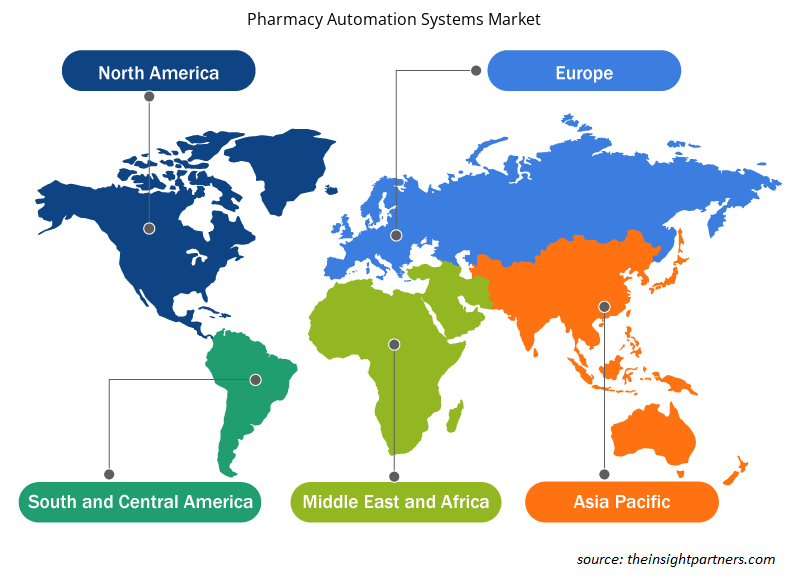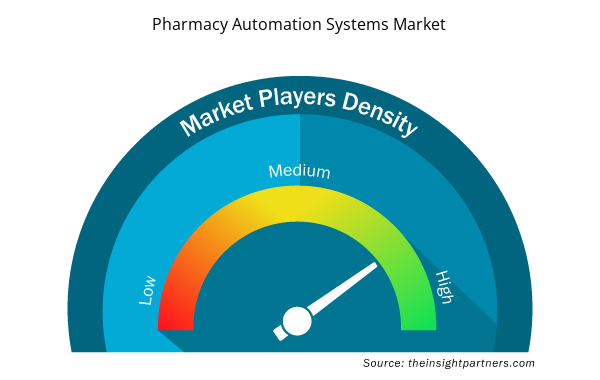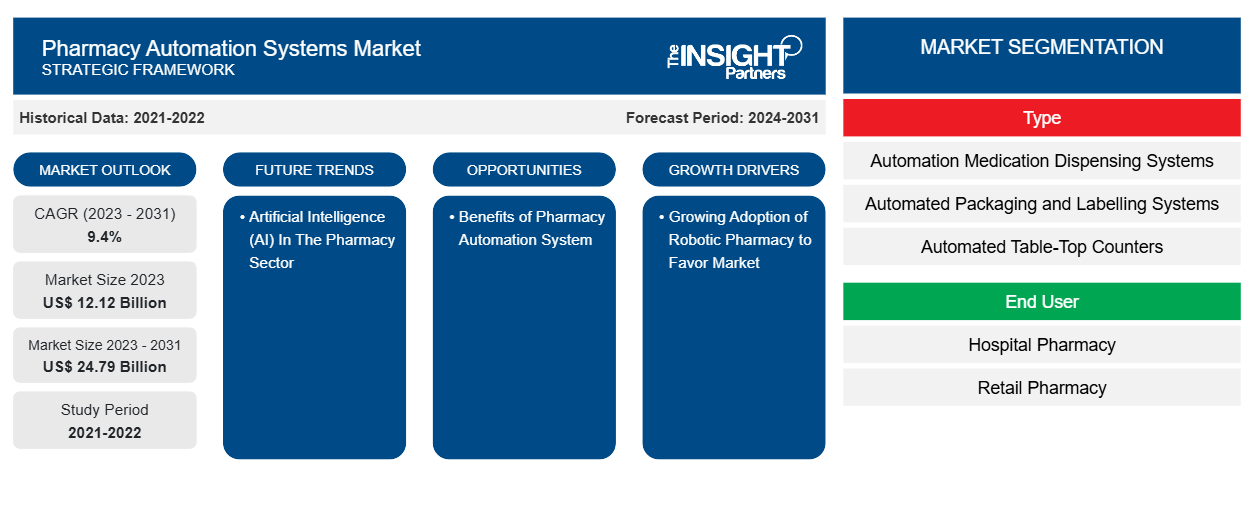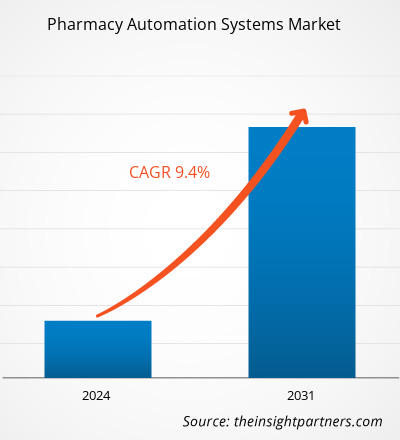Der Markt für Apothekenautomatisierungssysteme soll von 12,12 Milliarden US-Dollar im Jahr 2023 auf 24,79 Milliarden US-Dollar im Jahr 2031 anwachsen. Der Markt wird zwischen 2023 und 2031 voraussichtlich eine durchschnittliche jährliche Wachstumsrate von 9,4 % verzeichnen. Die Apothekenautomatisierung für die Telepharmazie dürfte ein wichtiger Trend auf dem Markt bleiben.
Marktanalyse für Apothekenautomatisierungssysteme
Die Präsenz mehrerer Marktteilnehmer und die zunehmende Zahl chronischer Krankheiten sind die Schlüsselfaktoren für das Marktwachstum. In Großbritannien entstehen der Regierung aufgrund vieler Medikationsfehler hohe Kosten. In einem Jahr werden fast 273 Fehlkalkulationen von Medikamenten festgestellt, die das Gesundheitssystem 79,4 Millionen US-Dollar (98 Millionen Pfund) kosten. Daher ergreifen die Betreibergesellschaften zusammen mit dem National Health Service (NHS) strategische Initiativen, um das Ausmaß der Fehler einzudämmen. Im Juni 2023 arbeitete Omincell UK & Ireland mit dem niederländischen Unternehmen Alphatron Medical zusammen, um den AMiS-PRO Smart Cart im Land auf den Markt zu bringen. Solche Fälle werden wahrscheinlich den Arbeitsablauf der Krankenschwestern bei der Medikamenteneinnahme verändern.
Marktübersicht für Apothekenautomatisierungssysteme
Zu den treibenden Faktoren auf dem Markt für Apothekenautomatisierungssysteme zählen niedrige Kosten, weniger medikamentenbezogene Fehler, ein besserer Apotheken-Workflow und eine gute Patientenerfahrung. Das Apothekenautomatisierungssystem bringt Apotheken enorme Vorteile. Darüber hinaus leiden ältere Menschen an einer oder mehreren chronischen Krankheiten wie Diabetes, Arthritis, Alzheimer oder Parkinson; die Behandlung dieser Krankheiten erfordert ein regelmäßiges Nachfüllen von Medikamenten . Daher wird die Nachfrage nach verschreibungspflichtigen Medikamenten mit der wachsenden alternden Bevölkerung in den kommenden Jahren exponentiell steigen. Derzeit umfasst die Automatisierung die automatische Abgabe, Verpackung, Lagerung, Etikettierung usw., um Abgabefehler zu reduzieren und die Produktivität der Apothekenleiter zu steigern.
Passen Sie diesen Bericht Ihren Anforderungen an
Sie erhalten kostenlos individuelle Anpassungen an jedem Bericht, einschließlich Teilen dieses Berichts oder einer Analyse auf Länderebene, eines Excel-Datenpakets sowie tolle Angebote und Rabatte für Start-ups und Universitäten.
- Holen Sie sich die wichtigsten Markttrends aus diesem Bericht.Dieses KOSTENLOSE Beispiel umfasst eine Datenanalyse von Markttrends bis hin zu Schätzungen und Prognosen.
Markttreiber und Chancen für Apothekenautomatisierungssysteme
Zunehmende Nutzung von Roboter-Apotheken begünstigt den Markt
Durch Automatisierung werden Apotheker von arbeitsintensiven Vertriebsfunktionen entlastet und die Arbeitsabläufe in Apotheken effizienter. Darüber hinaus werden Roboter und automatisierte Systeme immer beliebter, da das wachsende Netzwerk von Apotheken die Patientensicherheit erhöhen , Kosten senken und das Patientenerlebnis verbessern kann. Daher nehmen auch die Produkteinführungen zu. Im Mai 2023 erhielt ScriptPro von Drug Store News den Retail Excellence Award – Technology and Automation. DSN, die führende Publikation der Ketten- und Einzelhandelsbranche, stellt Apothekentechnologieunternehmen ins Rampenlicht, die das Beste für ihre Kunden anstreben. Darüber hinaus eröffnete die McKesson Corporation im Oktober 2022 ein neues hochmodernes Pharmavertriebszentrum in Jeffersonville, Ohio, zwischen Cincinnati und Columbus. Die neue Anlage wird pharmazeutische, rezeptfreie (OTC) und häusliche Gesundheitsprodukte (HHC) sowie verpackte Konsumgüter (CPG) an Kunden in Ohio, Indiana, Kentucky, Michigan, Pennsylvania und West Virginia vertreiben.
Künstliche Intelligenz (KI) im Apothekensektor
Heutzutage wird KI-Technologie von führenden Pharmaunternehmen für die Analyse von Gesundheitssystemen, die Arzneimittelentdeckung, die Genauigkeit von Medikamenten, Forschung und Entwicklung, Gesundheitsunterstützung und medizinische Betreuung, die Gestaltung von Behandlungsplänen, die Unterstützung bei sich wiederholenden Aufgaben und vieles mehr eingesetzt. KI bietet Möglichkeiten für verschiedene andere Branchen und Bereiche. Beispielsweise kann KI auch über Telemedizin-Partnerschaften, Bestandsverwaltung und die Verwendung von Chatbots zur Nachahmung von Interaktionen zwischen Patient und Apotheker implementiert werden. In Apotheken im Einzelhandel und in Krankenhausapotheken wird KI verwendet, um die Zubereitung von injizierbaren Medikamenten zu verfolgen, Barcodes zu scannen und vieles mehr. Mit solchen Funktionen wird die Einführung automatisierter Apothekensysteme in den kommenden Jahren auch in Entwicklungsländern zunehmen.
Marktbericht zu Apothekenautomatisierungssystemen – Segmentierungsanalyse
Schlüsselsegmente, die zur Ableitung der Marktanalyse für Apotheken-Automatisierungssysteme beigetragen haben, sind Typ und Endbenutzer.
- Basierend auf dem Typ ist der Markt für Apothekenautomatisierungssysteme in automatisierte Verpackungs- und Etikettiersysteme, automatisierte Medikamentenabgabesysteme, automatisierte Lager- und Bereitstellungssysteme, automatisierte Tischtheken und andere Typen unterteilt. Der Markt für Apothekenautomatisierungssysteme für den Typ der automatisierten Abgabesysteme ist in Produkt und Betrieb unterteilt. Das Segment der automatisierten Medikamentenabgabesysteme hatte im Jahr 2023 einen größeren Marktanteil.
- Basierend auf dem Endbenutzer ist der Markt für Apothekenautomatisierungssysteme in Krankenhausapotheken, Einzelhandelsapotheken und andere unterteilt. Das Segment der Krankenhausapotheken hatte im Jahr 2023 einen größeren Marktanteil.
Marktanteilsanalyse für Apothekenautomatisierungssysteme nach Geografie
Der geografische Umfang des Marktberichts zu Apotheken-Automatisierungssystemen ist hauptsächlich in fünf Regionen unterteilt: Nordamerika, Asien-Pazifik, Europa, Naher Osten und Afrika sowie Süd- und Mittelamerika.
Nordamerika dominiert den Markt und der asiatisch-pazifische Raum wird in den kommenden Jahren voraussichtlich die höchste durchschnittliche jährliche Wachstumsrate aufweisen. Das Wachstum des asiatisch-pazifischen Marktes ist auf den zunehmenden Einsatz künstlicher Intelligenz in der Medizintechnik, internationale Akteure, die in die Gesundheitsmärkte der Region eintreten, und die zunehmende geriatrische Bevölkerung zurückzuführen. Automatisierungstechnologien werden in der Gesundheitsbranche häufig eingesetzt und steigern die Nachfrage nach automatisierten Apothekensystemen. China ist der größte Exporteur von aktiven pharmazeutischen Inhaltsstoffen in westliche Länder und benötigt Automatisierung für die Verpackung und Etikettierung der zu versendenden Produkte. Außerdem sind in Produktionsstätten und Lagern automatisierte Apothekensysteme installiert. Die oben genannten Faktoren werden den Markt für Apothekenautomatisierungssysteme vorantreiben.
Regionale Einblicke in den Markt für Apothekenautomatisierungssysteme
Die regionalen Trends und Faktoren, die den Markt für Apothekenautomatisierungssysteme während des gesamten Prognosezeitraums beeinflussen, wurden von den Analysten von Insight Partners ausführlich erläutert. In diesem Abschnitt werden auch die Marktsegmente und die Geografie von Apothekenautomatisierungssystemen in Nordamerika, Europa, im asiatisch-pazifischen Raum, im Nahen Osten und Afrika sowie in Süd- und Mittelamerika erörtert.

- Erhalten Sie regionale Daten zum Markt für Apothekenautomatisierungssysteme
Umfang des Marktberichts zu Apothekenautomatisierungssystemen
| Berichtsattribut | Details |
|---|---|
| Marktgröße im Jahr 2023 | 12,12 Milliarden US-Dollar |
| Marktgröße bis 2031 | 24,79 Milliarden US-Dollar |
| Globale CAGR (2023 - 2031) | 9,4 % |
| Historische Daten | 2021-2022 |
| Prognosezeitraum | 2024–2031 |
| Abgedeckte Segmente | Nach Typ
|
| Abgedeckte Regionen und Länder | Nordamerika
|
| Marktführer und wichtige Unternehmensprofile |
|
Dichte der Marktteilnehmer für Apothekenautomatisierungssysteme: Die Auswirkungen auf die Geschäftsdynamik verstehen
Der Markt für Apothekenautomatisierungssysteme wächst rasant, angetrieben durch die steigende Endverbrauchernachfrage aufgrund von Faktoren wie sich entwickelnden Verbraucherpräferenzen, technologischen Fortschritten und einem größeren Bewusstsein für die Vorteile des Produkts. Mit steigender Nachfrage erweitern Unternehmen ihr Angebot, entwickeln Innovationen, um die Bedürfnisse der Verbraucher zu erfüllen, und nutzen neue Trends, was das Marktwachstum weiter ankurbelt.
Die Marktteilnehmerdichte bezieht sich auf die Verteilung der Firmen oder Unternehmen, die in einem bestimmten Markt oder einer bestimmten Branche tätig sind. Sie gibt an, wie viele Wettbewerber (Marktteilnehmer) in einem bestimmten Marktraum im Verhältnis zu seiner Größe oder seinem gesamten Marktwert präsent sind.
Die wichtigsten auf dem Markt für Apotheken-Automatisierungssysteme tätigen Unternehmen sind:
- McKesson Corp
- Becton Dickinson und Company
- Capsa Solutions LLC
- Omnicell Inc
- Oracle Corp
- Deenova Srl
Haftungsausschluss : Die oben aufgeführten Unternehmen sind nicht in einer bestimmten Reihenfolge aufgeführt.

- Überblick über die wichtigsten Akteure auf dem Markt für Apothekenautomatisierungssysteme
Marktnachrichten und aktuelle Entwicklungen zu Apothekenautomatisierungssystemen
Der Markt für Apothekenautomatisierungssysteme wird durch die Erhebung qualitativer und quantitativer Daten nach Primär- und Sekundärforschung bewertet, die wichtige Unternehmensveröffentlichungen, Verbandsdaten und Datenbanken umfasst. Nachfolgend sind einige der Entwicklungen auf dem Markt für Apothekenautomatisierungssysteme aufgeführt:
- Erfolgreiche Markteinführung des automatisierten Medikamentenabgabesystems der nächsten Generation von JVM, einem Tochterunternehmen von Hanmi Science, über den High-End-Roboterarm „MENITH“ auf dem europäischen Markt. (Quelle: Hanmi Science, Pressemitteilung, Oktober 2023)
- Deenova gab im Rahmen des 26. Kongresses der European Association of Hospital Pharmacists in Wien die Vorstellung von drei neuen innovativen Ergänzungen seiner preisgekrönten D3-Produktlinie mechatronischer Lösungen bekannt. AIDE-Cut ist eine von drei neuen modularen mechatronischen Lösungen von Deenova zum Umpacken oraler fester Medikamente in Einzeldosen. AIDE-Pack ist Deenovas neue Lösung zum Umpacken aller Formen von Medikamenten (oral und nicht oral) in Einzeldosenformat, und die AIDE-Pick-Lösung wurde entwickelt, um den Anforderungen der zentralisierten Therapievorbereitung in subakuten und/oder standortübergreifenden Gesundheitseinrichtungen gerecht zu werden. (Quelle: Deenova, Pressemitteilung, März 2022)
Marktbericht zu Apotheken-Automatisierungssystemen – Umfang und Ergebnisse
Der Bericht „Marktgröße und Prognose für Apothekenautomatisierungssysteme (2021–2031)“ bietet eine detaillierte Analyse des Marktes, die die folgenden Bereiche abdeckt:
- Marktgröße und Prognose für Apothekenautomatisierungssysteme auf globaler, regionaler und Länderebene für alle wichtigen Marktsegmente, die im Rahmen des Berichts abgedeckt sind
- Markttrends für Apothekenautomatisierungssysteme sowie Marktdynamik wie Treiber, Einschränkungen und wichtige Chancen
- Detaillierte PEST/Porters Five Forces- und SWOT-Analyse
- Marktanalyse für Apothekenautomatisierungssysteme mit Blick auf wichtige Markttrends, globale und regionale Rahmenbedingungen, wichtige Akteure, Vorschriften und aktuelle Marktentwicklungen3
- Branchenlandschaft und Wettbewerbsanalyse, die die Marktkonzentration, Heatmap-Analyse, prominente Akteure und aktuelle Entwicklungen auf dem Markt für Apothekenautomatisierungssysteme umfasst
- Detaillierte Firmenprofile
- Historische Analyse (2 Jahre), Basisjahr, Prognose (7 Jahre) mit CAGR
- PEST- und SWOT-Analyse
- Marktgröße Wert/Volumen – Global, Regional, Land
- Branche und Wettbewerbsumfeld
- Excel-Datensatz


- Industrial Inkjet Printers Market
- Vision Care Market
- Emergency Department Information System (EDIS) Market
- Aircraft MRO Market
- Greens Powder Market
- Bioremediation Technology and Services Market
- Saudi Arabia Drywall Panels Market
- Queue Management System Market
- Rare Neurological Disease Treatment Market
- Electronic Shelf Label Market

Report Coverage
Revenue forecast, Company Analysis, Industry landscape, Growth factors, and Trends

Segment Covered
This text is related
to segments covered.

Regional Scope
North America, Europe, Asia Pacific, Middle East & Africa, South & Central America

Country Scope
This text is related
to country scope.
Häufig gestellte Fragen
North America has dominated the pharmacy automation systems market.
Factors such as growing adoption of robotic pharmacy and its associated benefits will boost the market growth.
Pharmacy automation for telepharmacy is likely to remain a key trend in the market.
The pharmacy automation systems market size is projected to reach US$ 24.79 billion by 2031.
The market is expected to register a CAGR of 9.4% during 2023–2031.
Trends and growth analysis reports related to Life Sciences : READ MORE..
The Insight Partners performs research in 4 major stages: Data Collection & Secondary Research, Primary Research, Data Analysis and Data Triangulation & Final Review.
- Data Collection and Secondary Research:
As a market research and consulting firm operating from a decade, we have published and advised several client across the globe. First step for any study will start with an assessment of currently available data and insights from existing reports. Further, historical and current market information is collected from Investor Presentations, Annual Reports, SEC Filings, etc., and other information related to company’s performance and market positioning are gathered from Paid Databases (Factiva, Hoovers, and Reuters) and various other publications available in public domain.
Several associations trade associates, technical forums, institutes, societies and organization are accessed to gain technical as well as market related insights through their publications such as research papers, blogs and press releases related to the studies are referred to get cues about the market. Further, white papers, journals, magazines, and other news articles published in last 3 years are scrutinized and analyzed to understand the current market trends.
- Primary Research:
The primarily interview analysis comprise of data obtained from industry participants interview and answers to survey questions gathered by in-house primary team.
For primary research, interviews are conducted with industry experts/CEOs/Marketing Managers/VPs/Subject Matter Experts from both demand and supply side to get a 360-degree view of the market. The primary team conducts several interviews based on the complexity of the markets to understand the various market trends and dynamics which makes research more credible and precise.
A typical research interview fulfils the following functions:
- Provides first-hand information on the market size, market trends, growth trends, competitive landscape, and outlook
- Validates and strengthens in-house secondary research findings
- Develops the analysis team’s expertise and market understanding
Primary research involves email interactions and telephone interviews for each market, category, segment, and sub-segment across geographies. The participants who typically take part in such a process include, but are not limited to:
- Industry participants: VPs, business development managers, market intelligence managers and national sales managers
- Outside experts: Valuation experts, research analysts and key opinion leaders specializing in the electronics and semiconductor industry.
Below is the breakup of our primary respondents by company, designation, and region:

Once we receive the confirmation from primary research sources or primary respondents, we finalize the base year market estimation and forecast the data as per the macroeconomic and microeconomic factors assessed during data collection.
- Data Analysis:
Once data is validated through both secondary as well as primary respondents, we finalize the market estimations by hypothesis formulation and factor analysis at regional and country level.
- Macro-Economic Factor Analysis:
We analyse macroeconomic indicators such the gross domestic product (GDP), increase in the demand for goods and services across industries, technological advancement, regional economic growth, governmental policies, the influence of COVID-19, PEST analysis, and other aspects. This analysis aids in setting benchmarks for various nations/regions and approximating market splits. Additionally, the general trend of the aforementioned components aid in determining the market's development possibilities.
- Country Level Data:
Various factors that are especially aligned to the country are taken into account to determine the market size for a certain area and country, including the presence of vendors, such as headquarters and offices, the country's GDP, demand patterns, and industry growth. To comprehend the market dynamics for the nation, a number of growth variables, inhibitors, application areas, and current market trends are researched. The aforementioned elements aid in determining the country's overall market's growth potential.
- Company Profile:
The “Table of Contents” is formulated by listing and analyzing more than 25 - 30 companies operating in the market ecosystem across geographies. However, we profile only 10 companies as a standard practice in our syndicate reports. These 10 companies comprise leading, emerging, and regional players. Nonetheless, our analysis is not restricted to the 10 listed companies, we also analyze other companies present in the market to develop a holistic view and understand the prevailing trends. The “Company Profiles” section in the report covers key facts, business description, products & services, financial information, SWOT analysis, and key developments. The financial information presented is extracted from the annual reports and official documents of the publicly listed companies. Upon collecting the information for the sections of respective companies, we verify them via various primary sources and then compile the data in respective company profiles. The company level information helps us in deriving the base number as well as in forecasting the market size.
- Developing Base Number:
Aggregation of sales statistics (2020-2022) and macro-economic factor, and other secondary and primary research insights are utilized to arrive at base number and related market shares for 2022. The data gaps are identified in this step and relevant market data is analyzed, collected from paid primary interviews or databases. On finalizing the base year market size, forecasts are developed on the basis of macro-economic, industry and market growth factors and company level analysis.
- Data Triangulation and Final Review:
The market findings and base year market size calculations are validated from supply as well as demand side. Demand side validations are based on macro-economic factor analysis and benchmarks for respective regions and countries. In case of supply side validations, revenues of major companies are estimated (in case not available) based on industry benchmark, approximate number of employees, product portfolio, and primary interviews revenues are gathered. Further revenue from target product/service segment is assessed to avoid overshooting of market statistics. In case of heavy deviations between supply and demand side values, all thes steps are repeated to achieve synchronization.
We follow an iterative model, wherein we share our research findings with Subject Matter Experts (SME’s) and Key Opinion Leaders (KOLs) until consensus view of the market is not formulated – this model negates any drastic deviation in the opinions of experts. Only validated and universally acceptable research findings are quoted in our reports.
We have important check points that we use to validate our research findings – which we call – data triangulation, where we validate the information, we generate from secondary sources with primary interviews and then we re-validate with our internal data bases and Subject matter experts. This comprehensive model enables us to deliver high quality, reliable data in shortest possible time.


 Holen Sie sich ein kostenloses Muster für diesen Bericht
Holen Sie sich ein kostenloses Muster für diesen Bericht